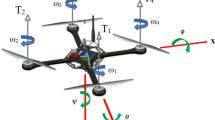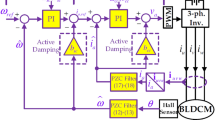Abstract
This work concerns the development of a integral sliding-mode tracking controller with friction estimator for a precision positioning stage. This stage is supported by cross roller guides, therefore, one of the main disturbances during dynamic motion is the friction force. In order to overcome the uncertainties and the effect of friction, an integral sliding-mode controller with uncertainty and disturbance estimation scheme is designed to control the motion of the stage. Comparing with conventional PID controllers, the experimental results show that with this controller the tracking errors can be reduced significantly.







Similar content being viewed by others
References
Al-Bender F, Swevers J (2008) Characterization of friction force dynamics. IEEE Control Syst Mag 28:64–81
Al-Bender F, Lampaert V, Swevers J (2005) The generalized Maxwell-Slip model: a novel model for friction simulation and compensation. IEEE Trans Autom Control 50:1883–1887
Armstrong-Heouvry B, Dupont P, De Wit C (1994) A survey of models, analysis tools and compensation methods for control of machines with friction. Automatica 30:1083–1138
Astrom K, Canudas de Wit C (2008) Revisiting the LuGre friction model. IEEE Control Syst Mag 28:101–114
Canudas de Wit C, Olsson H, Astrom K, Lischinsky P (1995) A new model for control of systems with friction. IEEE Trans Autom Control 40:419–425
Chen SL, Tan KK, Huang S (2009) Friction modeling and compensation of servo mechanical system with dual-relay feedback approach. IEEE Trans Control Syst Technol 17:1295–1305
Dahl P (1968) A solid friction model, Tech. Rep. The Aerospace Corp., El Segundo
De Wit C, Lischinsky P (1997) Adaptive friction compensation with partially known dynamic model. Int J Adapt Control Signal Process 11:65–80
Hensen R, van de Molengraft M, Steinbuch M (2003) Friction induced hunting limit cycle: a comparison between the LuGre and switch function model. Automatica 39:2131–2137
Kim SJ, Kim SY, Ha IJ (2004) An efficient identification method for friction in single-DOF motion control system. IEEE Trans Control Syst Technol 12:555–563
Lampaert V, Swevers J, AlBender F (2002) Modification of the Leuven integrated friction model structure. IEEE Trans Autom Control 47:683–687
Lin CJ, Lee CY (2011) Observer-based robust controller design and realization of a gantry stage. Mechatronics 21:185–203
Misovec K, Ammaswamy A (1998) Friction compensation using adaptive non-linear control with persistent excitation. Proceedings of the 1998 American Control Conference
Olsson H, Astrom K (2001) Friction generated limit cycles. IEEE Trans Control Syst Technol 9:629–636
Ramasubramaniam A, Ray L (2001) Stability and performance analysis of non-model-based friction estimators. Proceedings of the IEEE conference on decision and control
Rastko R, Lewis F (2002) Neural-network approximation of piecewise continuous functions: application to friction compensation. IEEE Trans Neural Netw 13:745–751
Ray L, Ramasubrabraniam A, Townsend J (2001) Adaptive friction compensation using extended Kalman–Bucy filter friction estimation. Control Eng Pract 9:169–179
Rizos D, Fassois S (2004) Presliding friction identification based on the Maxwell Slip model. Chaos Interdiscip J Nonlinear Sci 14:431–445
Rizos D, Fassois S (2009) Friction identification based upon the LuGre and Maxwell-Slip models. IEEE Trans Control Syst Technol 17:153–160
Swevers J, Al-Bender F, Ganseman C, Prajogo T (2000) An integrated friction model with improved presliding behavior for accurate friction compensation. IEEE Trans Autom Control 45:675–686
Utkin V, Shi J (1996) Integral sliding mode in systems operating under uncertainty conditions. Proceedings of the 35th conference on decision and control
Utkin V, Guldner J, Shi J (1999) Sliding mode control in electromechanical systems. Taylor & Francis, London
Acknowledgments
This work is supported by National Science Council of Taiwan under project NSC-100-2221-E-150-031.
Author information
Authors and Affiliations
Corresponding author
Rights and permissions
About this article
Cite this article
Shen, JC., Yan, CC. Tracking control of a precision stage with integral sliding-mode friction estimator. Microsyst Technol 19, 1731–1736 (2013). https://doi.org/10.1007/s00542-013-1858-0
Received:
Accepted:
Published:
Issue Date:
DOI: https://doi.org/10.1007/s00542-013-1858-0




